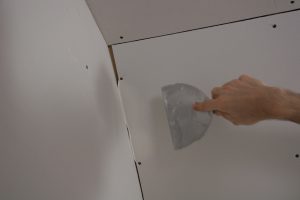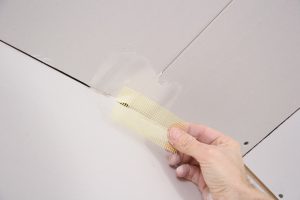Prep Before Taping
By Myron Ferguson
What I have always liked about taping drywall is that it is fast moving work. There is a lot of energy in the air when we walk into a freshly hung job and get ready to start embedding the tape. And embedding the tape is really what we want to do as soon as we walk in the door. But quite often there is a list of details that should be addressed before taping can begin.
This is my routine for addressing these issues. I mix up a pan full of setting compound, put a handful of screws in my pocket or tool pouch, along with a utility knife, stick a few feet of mesh tape to my shirt, and I put a cordless drill with a screw setting attachment on my belt. I tell the taping crew where I will be starting and I will move from room to room in a clockwise direction. I use the compound to prefill any gaps over 1/8”. I am also looking for areas that are not properly fastened and I put in the needed screws. I also remove any screws that are misses and reset any screws that are poorly set. I use the utility knife to cut away any damaged areas or loose paper along seams, especially butted seams. The mesh tape is used over damaged areas that will also get a quick coat of the setting compound. Doing all this will greatly increase the efficiency of the tapers. They can simply walk in the room and start embedding tape.
If I am not there I make sure someone is in charge and will do the pre-taping walkthrough. If a crew decides that this prep before taping isn’t that important and decide to just skip over this step there may be problems down the road. If screws are missing in corners and are not installed the result could be cracks when baseboard or crown is installed and could also result in crooked inside corners. If screws have been set too deep and aren’t fixed then screw pops may be showing up later. Prefilling gaps with a setting compound the day of taping or enough in advance to allow time for the regular compound to dry can prevent cracks or recessed areas from forming when the compound does finally dry completely. Of course cutting away loose or damaged drywall and repairing is a must.
Adding this step of preparing for taping actually increases production even though it is adding a step. This “Working Smarter Not Harder” has the benefit of increasing production which is often thought of as the chief benefit, but what I believe is more important is the increased finished and lasting quality of the drywall work.
Keep in mind that if the hanging crew does their job properly there really are not many problems that have to be addressed before taping can begin. But there will always be gaps, damaged drywall edges, and the occasional poorly set screw. FIX THEM BEFORE YOU START APPLYING TAPE AND COMPOUND.


Are you saying that uneven drywall joints should be leveled with mud before taping? I had to put in a piece of drywall where an arched window over the bedroom windows had been. when I fastened the drywall on, there were a couple spots that are uneven. Your curved wall taping technique also doesn’t seem to work so I will have to tape in sections.
is that right?
Prefilling can’t hurt. Depending on the situation you could embed the tape right away. Not sure what you mean about the curved wall technique.